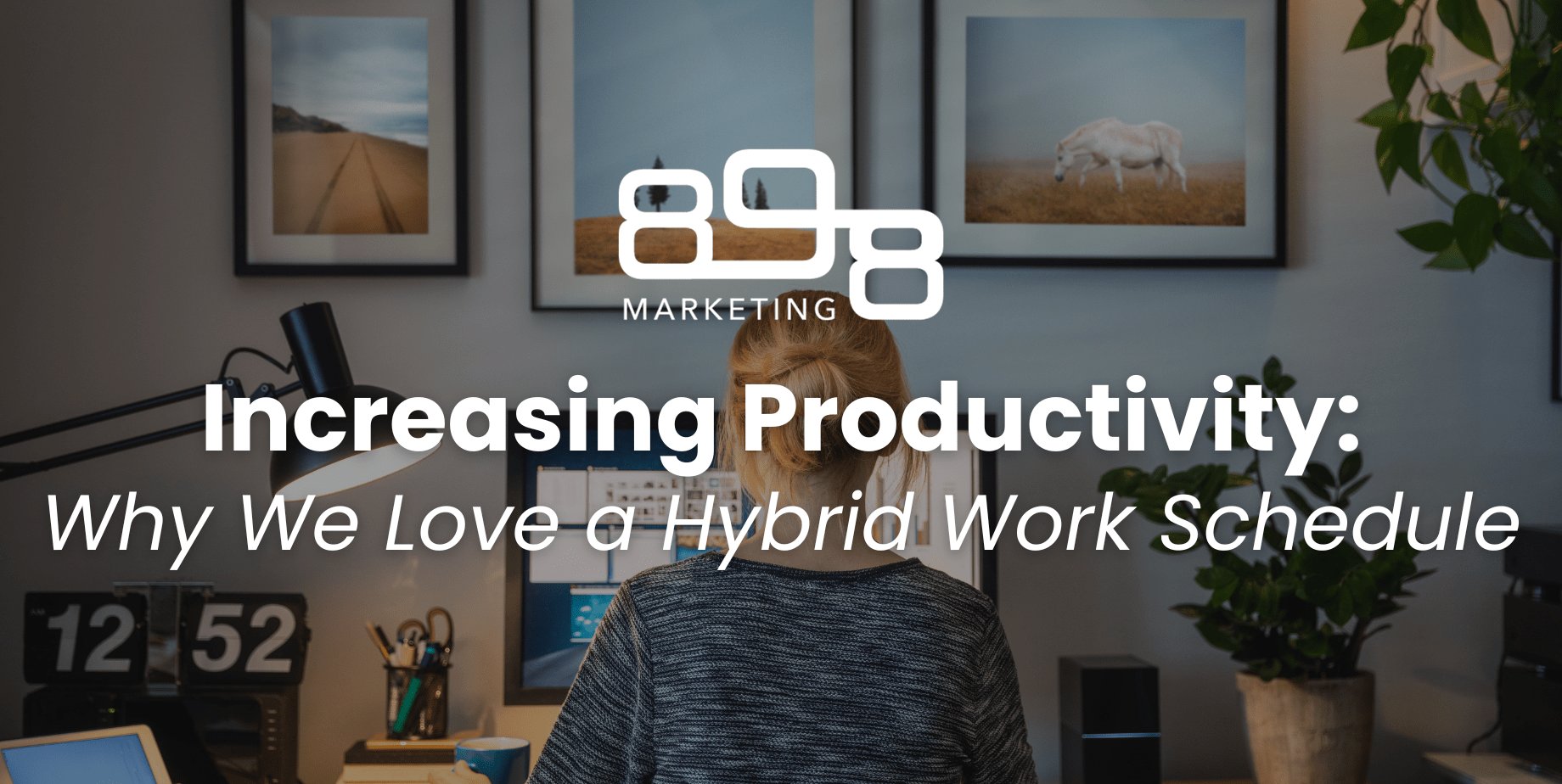
Increasing Productivity: Why We Love a Hybrid Work Schedule
- Lexi Marco
- October 12, 2023
- Blog
- Hybrid Work Schedule, Marketing Agency, Work-Life Balance
- 0 Comments
You may have heard of a hybrid work schedule by now, especially with hybrid schedules becoming wildly popular since the rise of COVID cases across the country. While some offices went fully remote during the worldwide pandemic, others incorporated a hybrid schedule to reap the benefits of both an in-office and work from home atmosphere.

Hybrid schedules all function differently, depending on the workplace. At 898 Marketing, we incorporate a hybrid schedule into our routines by working from home on Tuesdays and Fridays each week and work in-office Monday, Wednesday and Thursday. Let’s explore some other types of hybrid work models:
Office-first Hybrid Schedule
An office-first schedule prioritizes employees in an office setting majority of the week. Work from home days can be as much as twice a week or as little as once a month. An office-first schedule can be good for employees who need to be in-office to meet with clients with flexibility to create their own schedule such as those in finance or even counselors/therapists.
Remote-first Hybrid Schedule
A remote-first type of schedule gives employees the ability to work from home with an option to come into the office. Typically, employees can come into the office when they have meetings, whether that be once a week or once a month. This type of schedule has the potential to get chaotic if there are no boundaries or set expectations for employees to come into the office. If you are an employer, be sure to communicate your work from home expectations with your team.
Fixed Hybrid Schedule
We like to think of a fixed hybrid schedule as the best of both worlds. In this hybrid schedule, companies set certain days or times that employees are expected to be in-office. Marketing, advertising and sales teams can benefit from a fixed schedule dependent on their flexibility with clients and other team members.
But, what are the benefits of a hybrid work schedule?
For employees:
A hybrid work schedule allows employees to collaborate with one another while also maintaining a certain level of independence. Fully remote positions can be isolating while fully in-office schedules can be stuffy and easy to experience declines in creativity. Working from home gives employees more clarity and can increase productivity. When given the choice of what hours to work in a day, employees can choose to work during their most productive hours.
For example, you might be an early riser and enjoy waking up early to start your day, but your friend is a night owl and functions best in the evening hours. A typical office setting is 9am to 5pm, making flexible hours difficult to manage.
For employers:
Hybrid schedules are now what job-searching employees look for in a potential employer. While everyone has different preferences, most employees value a work-life balance and, when it comes down to a decision, will choose the job with the most flexibility. Incorporating a flexible work schedule into your business sets you apart from fully in-office employers. As an employer, it’s important to trust that your team is getting work done from home. According to Forbes, 76.5% of managers believe that flexible working generally increases productivity.
How do I incorporate a hybrid work schedule into my business?
Setting goals and expectations for employees’ work habits is a great way to begin incorporating a hybrid schedule. Employees should be clear on what tasks to prioritize from home versus in the office, if any. It’s also crucial to ensure your employees are set up for success in a hybrid model. Employees should be prepared with laptops, adequate Wi-Fi and have access to important files or hard drives. If your business model cannot afford to supply or aid in the necessary materials, a hybrid schedule may not be the best option for your workplace.

What our team has to say about a hybrid work schedule:
“I really enjoy working a hybrid schedule because I can come into the office on the expected days, get some work done and collaborate with coworkers. On the flip side, I’m able to focus on specific, lengthy tasks that require more attention while I am at home. It’s a great work-life balance!” – Lexi, Social Media Coordinator
“I like the hybrid work schedule because I get to enjoy time at home while I work, and accomplish additional tasks like doing laundry while still getting my work done. It’s also nice to still have the opportunity to come to the office throughout the week and see my coworkers and clients in-person, face-to-face, and more easily tackle projects that require assistance from others.” – Zach, Account Manager
“Working in an open workspace without any offices or cubicles is great for collaboration, but can be distracting when working on a solo project that requires great focus and concentration. Our hybrid work schedule allows us to have days that we can work independently while working remote in an environment conducive to intense focus when needed.” – Cailyn, Account Manager
Related Posts

- Jimmy Kerrigan
- July 9, 2021
Take A Peek Behind the Curtain of Digital Advertisements
For the longest time, people followed in the steps of the Wizard of Oz, echoing the notion not ..

- Shelby Byrne
- July 15, 2021
A Day in the Life of an 898 Marketing Intern
Starting your first internship is an exciting and nerve racking experience, at least for me ..





Recent Comments